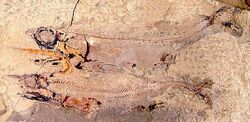| Falcatus Fossil range: Devonian to Carboniferous | |
|---|---|
 Fossil with female (top) and male (bottom) Falcatus falcatus. | |
| Scientific classification
| |
|
Falcatus | |
| |

Dorsal spine of a male.
Falcatus falcatus (the name refers to the sickle-shaped first dorsal fin spine) is an extinct species of small cladodont-toothed stethacanthid shark from the genus Falcatus. It is placed in its own family, Falcatidae, along with, and closely related to, Damocles serratus. It ranges up to about l0-12 inches in length. It was the most abundant shark in the Bear Gulch bay. Individuals were ubiquitous, but schools of this shark have been found in the central basin, in open water. The habitat of the juveniles is unknown. It was a small, generalized predator, known to have fed on shrimp.
Description[]
Paleobiology[]
The large soft rostrum strongly suggests that they had an ampullary sensory system for electric detection of prey, like that of modern sharks. Large eyes suggest a strongly visual predator as well. The pectoral fin has a trailing whip for maneuverability as in all stethacanthids. The nearly symmetrical high aspect ratio tail suggests a cruiser rather than a sedentary shark. Falcatus was countershaded, darker above and lighter below; possibly similar to the sediment color (tan) - with head and spine probably colorful in males, for advertisement.
Note also that Falcatus falcatus had very large eyes and many sclerotic bones in the sclerotic coat of the eyes, which are unusual for a shark.
Sexual dimorphism[]

A female Falcatus falcatus biting the shoulder spine of a male, possibly as a prelude to mating. Paleoichthyologist Richard Lund actually found a pair of Falcatus preserved together in this position.
Females lack scales. Sexually mature males have denticles on the tops of their heads, and fine denticles on the dorsal rod (that is a transformed dorsal fin). Mature males also have a notably longer snout than females. Most characteristically, as in all known stethacanthids, the females do not develop either the first dorsal fin or the spine, while the males develop their distinctive structures only at maturity.
References[]
- Lund, R. 1985. "The morphology of "Falcatus falcatus" (St. John and Worthen), a Mississippian stethacanthid chondrichthyan from the Bear Gulch Limestone of Montana." Jour. Vert. Paleo., 5: 1-19.